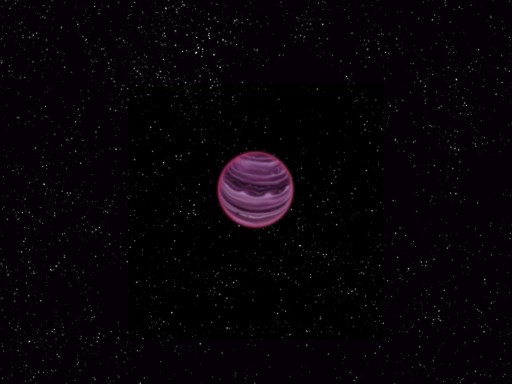A strange lonely planet found without a star
October 11, 2013
[+]
An international team of astronomers has discovered
an exotic young planet that is not orbiting a star. This free-floating
planet, dubbed PSO J318.5-22, is just 80 light-years away from Earth and
has a mass only six times that of Jupiter. The planet formed a mere 12
million years ago — -a newborn in planet lifetimes.
Artist’s conception of PSO J318.5-22 (credit: MPIA/V. Ch. Quetz)
It was identified from its faint and unique heat signature by the Pan-STARRS 1 (PS1) wide-field survey telescope on Haleakala, Maui. Follow-up observations using other telescopes in Hawaii show that it has properties similar to those of gas-giant planets found orbiting around young stars.
[+]
“We have never before seen an object free-floating in space that that
looks like this. It has all the characteristics of young planets found
around other stars, but it is drifting out there all alone,” explained
team leader Dr. Michael Liu of the Institute for Astronomy at the University of Hawaii at Manoa. “I had often wondered if such solitary objects exist, and now we know they do.”
Multicolor
image from the Pan-STARRS1 telescope of the free-floating planet PSO
J318.5-22, in the constellation of Capricornus. The planet is extremely
cold and faint, about 100 billion times fainter in optical light than
the planet Venus. Most of its energy is emitted at infrared wavelengths.
The image is 125 arcseconds on a side. (Credit: N. Metcalfe &
Pan-STARRS 1 Science Consortium)
Abstract of Astrophysical Journal Letters paper
We have used Pan-STARRS1 to discover an extremely red late-L dwarf, which has (J-K)_MKO = 2.84 and (J-K)_2MASS = 2.78, making it the reddest known field dwarf and second only to 2MASS J1207-39b among substellar companions. Near-IR spectroscopy shows a spectral type of L7 and reveals a triangular H-band continuum and weak alkali (K I and Na I) lines, hallmarks of low surface gravity. Near-IR astrometry from the Hawaii Infrared Parallax Program gives a distance of 24.6+/-1.4 pc and indicates a much fainter J-band absolute magnitude than field L dwarfs. The position and kinematics of PSO J318-22 point to membership in the beta Pictoris moving group. Evolutionary models give a temperature of 1160 (-40,+30) K and a mass of 6.5 (-1.0, +1.3) Mjup, making PSO J318-22 one of the lowest mass free-floating objects in the solar neighborhood. This object adds to the growing list of low-gravity field L dwarfs and is the first to be strongly deficient in methane relative to its estimated temperature. Comparing their spectra suggests that young L dwarfs with similar ages and temperatures can have different spectral signatures of youth. For the two objects with well constrained ages (PSO J318-22 and 2MASS J0355+11), we find their temperatures are ~400 K cooler than field objects of similar spectral type but their luminosities are comparable, i.e., these young L dwarfs are very red and unusually cool but not “underluminous.” Altogether, PSO J318-22 is the first free-floating object with the colors, magnitudes, spectrum, luminosity, and mass that overlap the young dusty planets around HR 8799 and 2MASS J1207-39.
(¯`*• Global Source and/or more resources at http://goo.gl/zvSV7 │ www.Future-Observatory.blogspot.com and on LinkeIn Group's "Becoming Aware of the Futures" at http://goo.gl/8qKBbK │ @SciCzar │ Point of Contact: www.linkedin.com/in/AndresAgostini
 Washington
Washington